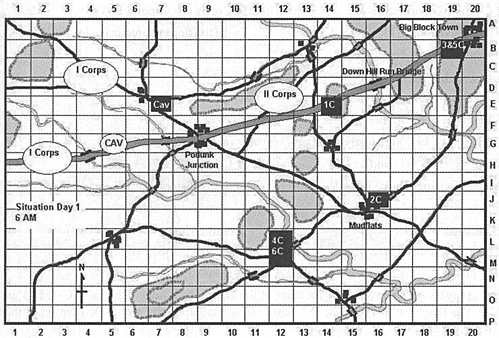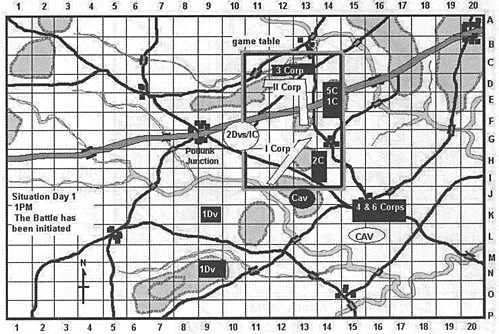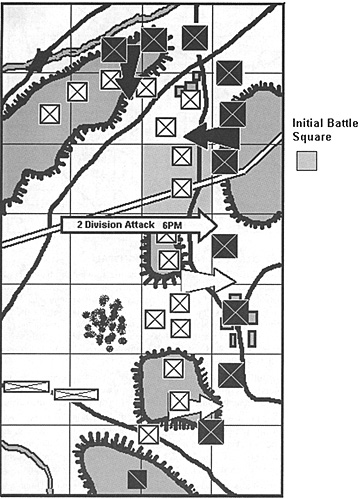 Just to give an idea of how the system works, here is a campaign played using the first campaign map and OOB provided. The campaign game took about 30 minutes to resolve face-to-face before setting up the table. The Blue Army became a Confederate force led by General Robert E. Leigh, while the Red force was the Army of the Potomack, commanded by General Jon Pop. Leigh knew that the Union were east and south of his two corps, but where was the question. General Pop, on the other hand, had heard rumors that the Rebels were coming down the main pike with the goal of severing his lines-of-communication. He knew his army was marginally larger, so he had hopes making the Rebels pay for the attempt.
Just to give an idea of how the system works, here is a campaign played using the first campaign map and OOB provided. The campaign game took about 30 minutes to resolve face-to-face before setting up the table. The Blue Army became a Confederate force led by General Robert E. Leigh, while the Red force was the Army of the Potomack, commanded by General Jon Pop. Leigh knew that the Union were east and south of his two corps, but where was the question. General Pop, on the other hand, had heard rumors that the Rebels were coming down the main pike with the goal of severing his lines-of-communication. He knew his army was marginally larger, so he had hopes making the Rebels pay for the attempt.
6AM CAMPAIGN SITUATION
The Union general is sure that the Rebels will come down the main road intent on cutting the Union LOC at Big Block Town. He plans to concentrate his entire army around his lCorps, hopefully taking the Confederates in flank by moving north from Mudflats. His two cavalry brigades, while isolated, might be able to learn the intentions of the Rebels and delay them a bit.
The Confederate player wanted to move fast, rather than search extensively for the Union forces. The II Corps will move to the Down Hill Run Bridge to block any Union thrust from the West. The I Corps meanwhile will move down towards Mudflats and then hook up towards Big Block Town. Hopefully catching a good portion of the Union in between. At worst, the two corps will be in position to support each other. The Cavalry was to move ahead and south of the I Corps and ferret out the Union, disrupting their movements if possible.
1 PM CAMPAIGN SITUATION
As the day developed, the Union cavalry is pushed back, but leaves the Union with the impression that the entire Confederate army is coming down the main road. The Union cavalry does delay two Confederate divisions, however. He moves the 3Corps north to outflank the anticipated Rebel move, the land 5 Corps crossing the bridge on the main road before the Confederates can get there. The Confederate cavalry moves quickly down the road southeast of Podunk Junction, then cuts west brushing up against two Union divisions. The Rebels have one infantry brigade and some artillery with them. The first encounters leave the Union with the impression that a major thrust by the Rebels is coming from West directly at Mudflats.
By 1PM, the confrontation east of Down Hill Run Bridge has developed into a battle. The area that was decided on as the battle map for the table is indicated, four miles by seven miles, a little smaller than a 10' x 6' table. It could easily have fit on a 9' x 5'.
 THE BATTLE OF CHUTNEY RUN: 2PM TO NIGHTFALL
THE BATTLE OF CHUTNEY RUN: 2PM TO NIGHTFALL
The Volley and Bayonet Civil War rules were used, creating a seven turn battle, 2PM to 8PM. The eighth turn and after is in the dark, 9PM. The map shows where the battle started by resolving a situation in the tinted square. The map was drawn with the square somewhere in the middle of the board, but no dead center. The main actions for the afternoon are shown. The only significant secondary terrain generated were the woods in the lower center and the village at the top of the map. As can be seen, the terrain strongly favored the defense for both sides. While the Confederates claimed to have chosen the terrain for the battle, it seems to have develop more by chance.
The Union 2 Corps was fully deployed, while the rest of the Union forces entered the table in road column. Two divisions of the Confederate II Corps were deployed, with the rest setting up in road column along the main and minor roads to the east of the map center.
The afternoon battle quickly developed into two actions. To the North, three Union corps attacked the Rebel II Corp on two sides, while the larger Confederate I Corps, with three Divisions and 9 brigades attacked the Union 2 Corps, which was present with only two of it's three divisions and 8 brigades. The Union cavalry came on as a small reinforcement to the south, but by four o'clock the Union 2 Corps was being seriously pressured.
To the north, the Rebels were hard pressed too, with fourteen brigades to the Union's seventeen. They were being attacked from two directions. The battle became a race to see which half of the battlefield would be decisive. The Confederates to the north were being worn down by the Federal pounding, while the Union 2 Corps to the south was fighting for it's life, barely holding on. Both the fight for the Union center and left/south flank were desperate.
The Union center had been breached and the two fresh Rebel Divisions pushed through and off the table as the Union forces to the North retreated east. As night fell, the Union army was divided strategically, but unlike the Rebels, still had six fresh divisions. The battle was a Confederate victory, but none of the victory conditions had been met, so strategically it was still a draw. Both players knew that a second campaign day would be necessary to determine a victor.
As there was still time after the battle, the players completed the next campaign day. Because the Confederates sat on the main road to Big Block Town, they easily won the race to the Union LOC the next day, with the II Corps facing North and the I Corps facing south, ready to meet any Union counter attacks. The Union player conceded, but we filed away the final strategic situation to be use when our next pickup game was planned. Its entitled "Union counter-attack."
DEBRIEFING:
The Union player realized that his plan was predicated on finding the Confederates, and so he spent too much time searching with his army dispersed, rather than concentrating it. A critical mistake. The Confederate on the other hand, carried out his plan, finding the enemy only when they were in the way of his movement towards his objective. The cavalry was used, not to search, but to confuse, which it did. Having an infantry brigade with them during the initial contacts proved far more valuable than if the brigade had been on the battlefield. The delay of the two Confederate divisions by the luckless Union cavalry actually proved decisive, not just on the battlefield, but in delaying the Union 4 and 6 Corps for two critical hours while they searched for them further south.
If there is any interest, we can provide a number of campaign situations we have used from historical campaigns ranging from 1760 to 1870. Enjoy.
[The first campaign is the 2nd Manassas campaign 1862, beginning August 29th, the day the battle began-sort of. The second campaign is Hood's Tennessee Campaign in the winter of 1864. The campaign begins with the Union General Schofield being outflanked and trying to race ahead of the Rebels to protect Franklin and Louisville to the north off the map. Obviously all Corps numbers given for the campaigns are generic.]
Campaign Lite Creating Interesting Pick-Up Games in a 1/2 Hour
 As it turned out, the Union concern with a possible Rebel southern force keep the 4 and 6 Corps plus the two stray divisions from reinforcing the 2 Corps. They searched for phantom Rebel divisions for two precious hours. When the two delayed Confederate divisions finally appeared behind the I Corps and plowed into the worn 2nd Corps, it was too late. Of the two divisions of the 4 Corps sent to shore up the 2 Corp, one actually rolled a seven and took a wrong road, taking a two hour walk towards Big Block Town. The other division arrived at 7PM just in time to cover the collapse and rout of the 2 Corps.
As it turned out, the Union concern with a possible Rebel southern force keep the 4 and 6 Corps plus the two stray divisions from reinforcing the 2 Corps. They searched for phantom Rebel divisions for two precious hours. When the two delayed Confederate divisions finally appeared behind the I Corps and plowed into the worn 2nd Corps, it was too late. Of the two divisions of the 4 Corps sent to shore up the 2 Corp, one actually rolled a seven and took a wrong road, taking a two hour walk towards Big Block Town. The other division arrived at 7PM just in time to cover the collapse and rout of the 2 Corps.
Back to MWAN # 130 Table of Contents
Back to MWAN List of Issues
Back to MagWeb Magazine List
© Copyright 2004 Hal Thinglum
This article appears in MagWeb.com (Magazine Web) on the Internet World Wide Web.
Other articles from military history and related magazines are available at http://www.magweb.com